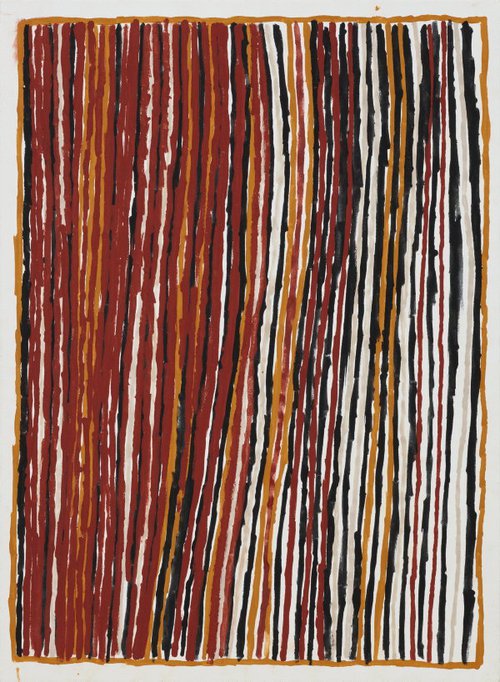Timothy Cook
Australia
Born: Melville Island, Northern Territory, Australia 08 Sep 1958
Language group: Tiwi, North region
Biography
Timothy Cook is a prolific painter who works through Jilamara Arts and Crafts at Milikapiti on Melville Island. Cook’s Murrakupupuni (Country) is Mananowmi, a region of the Goose Creek area); his yoyi (dance) is the tartuwali (shark); and the martupuni (house fly) is his yimunga (skin group), which he has inherited from his matrilineal line. He uses loose and gestural Tiwi designs to explore the stories of Kulama (the coming-of-age ceremony), Japarra (the moon) and Japalinga (the stars).
Since 2003 Cook has developed an idiosyncratic style using turtiyanginari (locally sourced natural pigments) to celebrate his familial inheritance. ‘I will take a painting to heaven so my mother will recognise me,’ he has said. Cook’s paintings on the theme of Kulama are, as described by journalist Nicolas Rothwell, presentations of an ‘airy geometry of heaven and earth’.
Cook favours parlingarri jilamara (old designs), which he learnt from growing up with the wulimawi (Old People). These are unique and striking combinations of kurluwukari (circles), pwanga (dots) and marlipinyini (lines) that make up jilamara – the practice of painting designs on the body in natural pigments and in the complex visual culture of the Tiwi.
In his early work Untitled 2002 now in the Art Gallery of New South Wales collection, Cook has painted alternating lines of red, white and yellow pigment in vertical directions, giving the canvas an energy of cadence and rhythm. Cook is referring to the body paint designs used in the Pukumani ceremony, the funerary practice that remains a cornerstone of Tiwi belief. The influence of senior Tiwi artist Kutuwulumi Purawarrumpatu Kitty Kantilla on Cook’s artistic experimentation is evident here, as Cook borrows from her style of employing natural pigments against a white background.
Yet Cook is most regarded for his dedication to imagery of the Kulama ceremony. Kulama is the deeply important coming-of-age ceremony that coincides with the harvest of wild yam. The ceremony is performed late in the wet season, when a ring or halo appears around Japarra (the moon). Elders sing or call out for three days, welcoming the children into adulthood. The Elders perform the ceremony on a prepared group of concentric circles, at the centre of which round yams are prepared for eating.
In Kulama 2009, also in the Art Gallery collection, Cook dramatically captures the atmospheric effect of the ringed moon. Encompassed within its circular lunar ripples are myriad tiny dots. For Cook, these marks represent multitudes of people, reflecting his concern for humanity.
The use of bold, scaled-up imagery is distinctive to the artist’s practice, and is enhanced by the rich texture and colour of the locally sourced natural pigments. It is present not only in Kulama 2009 but also in the artwork commissioned by the Art Gallery for the harbour terrace of the North Building – Kulama – warnarringa, japarra amintiya japalinga (sun, moon and stars) 2023.
Like other key Tiwi artists represented in the Art Gallery’s collection, including Kantilla, Freda Warlapinni and Pedro Wonaeamirri, Cook has created a dynamic new visual perspective of Tiwi culture.


